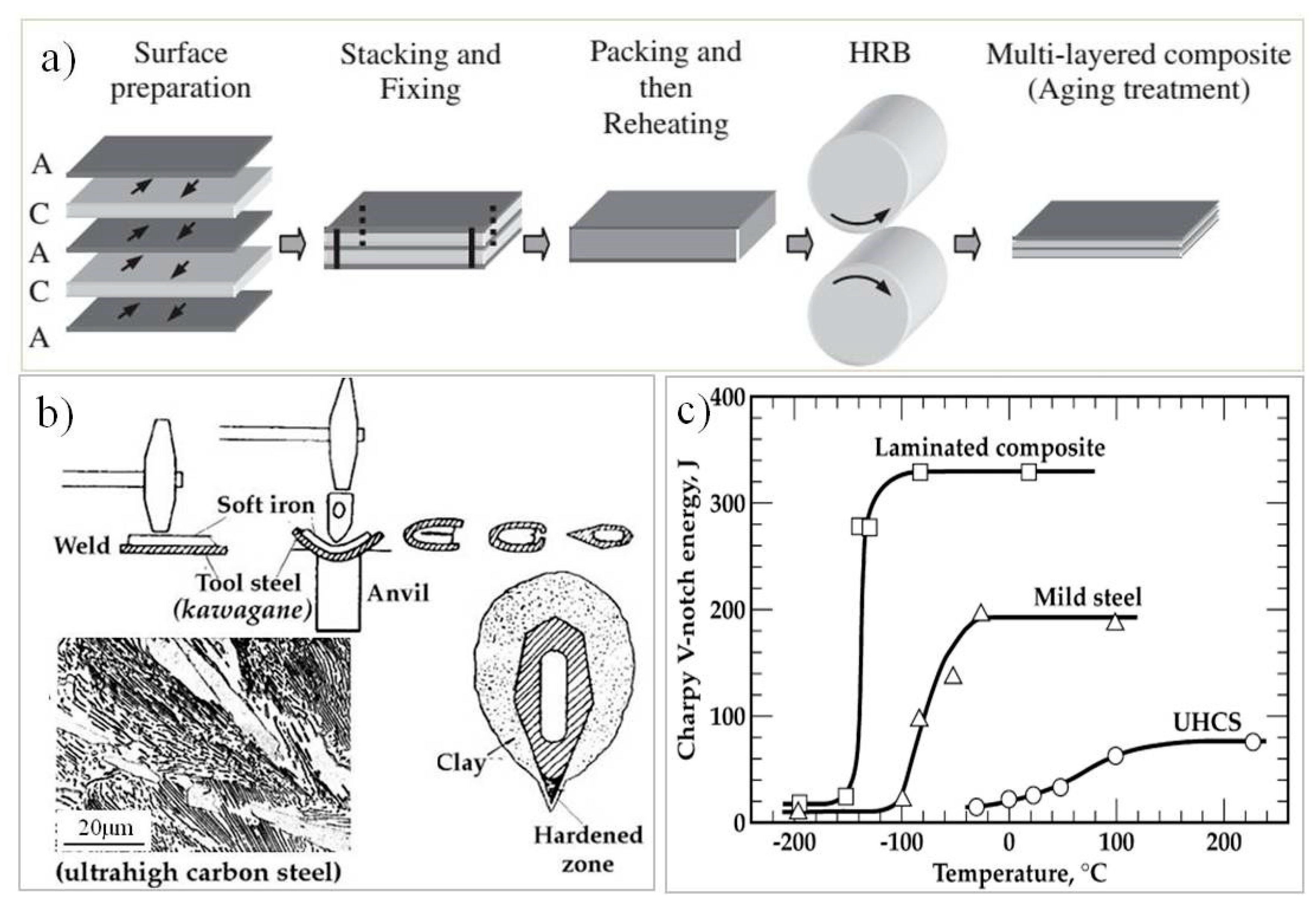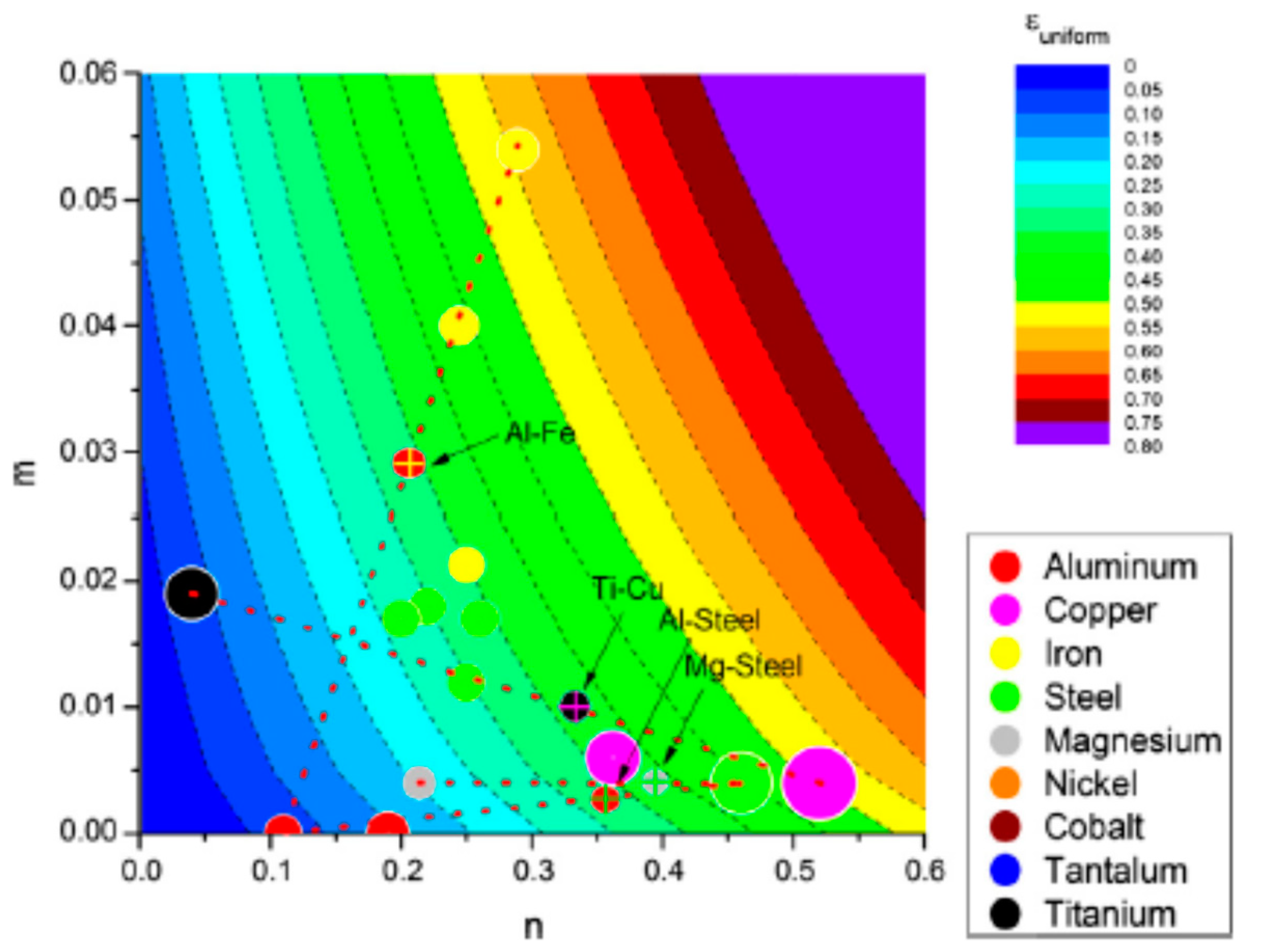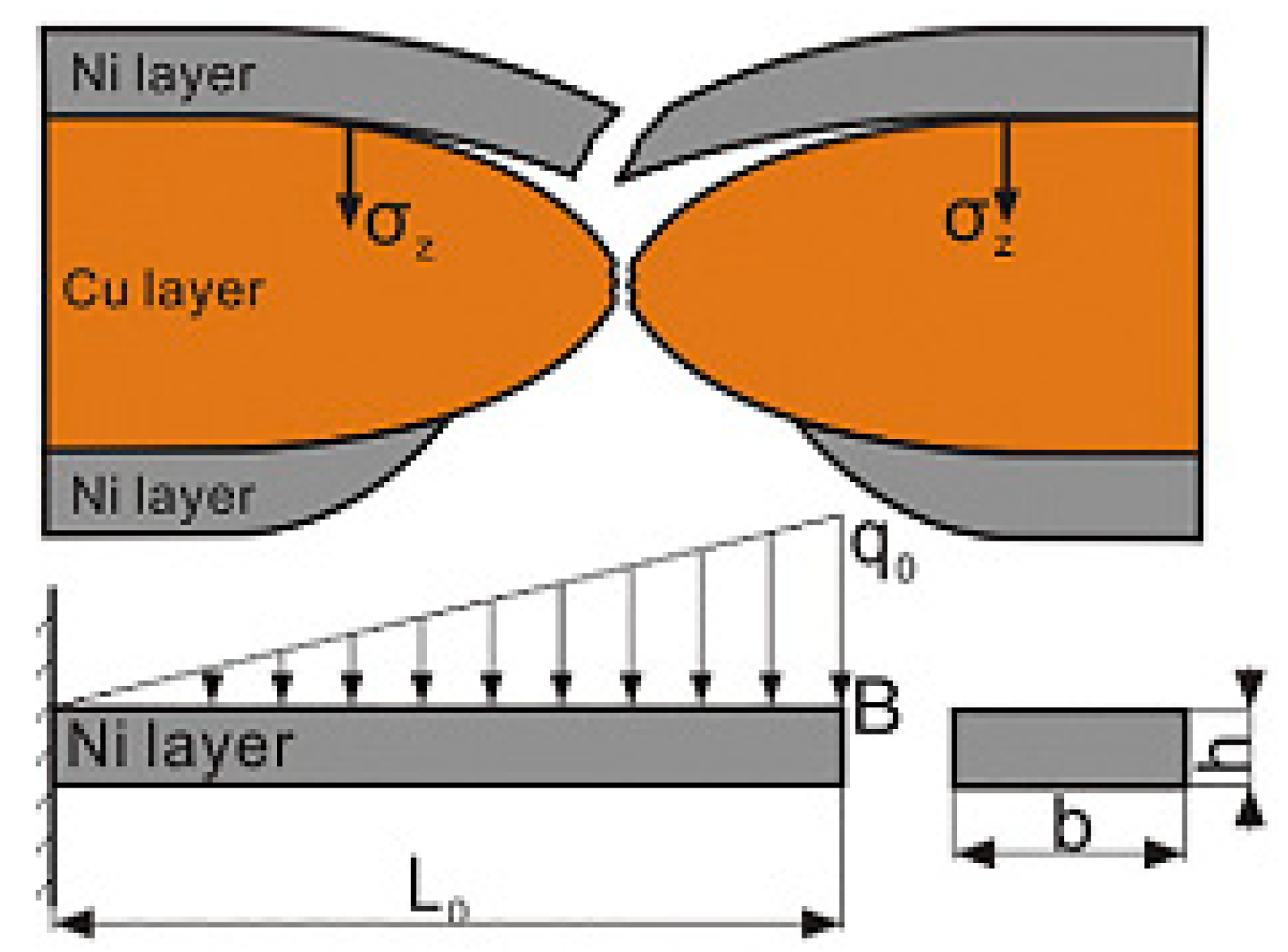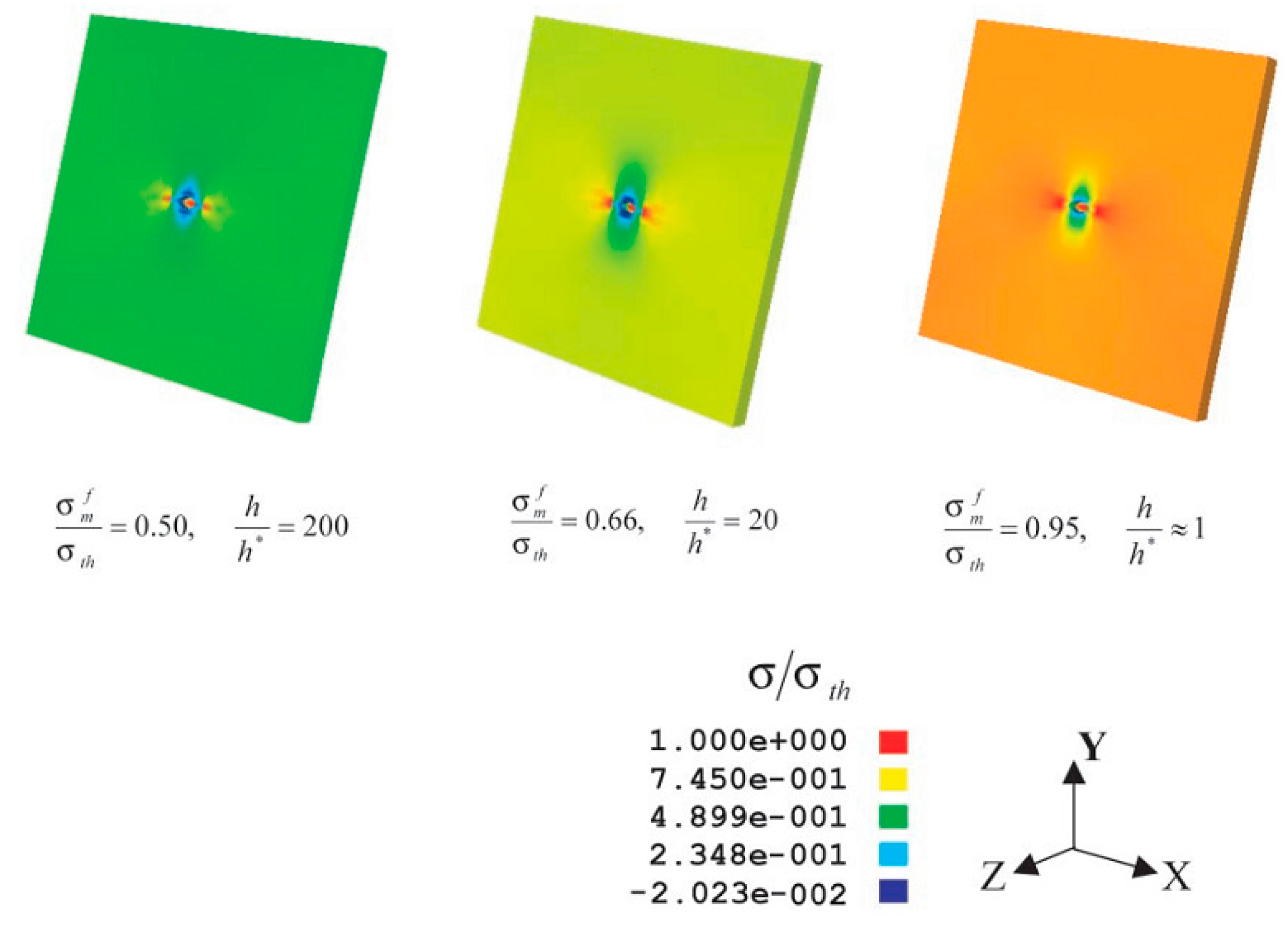The Deformation Characteristics, Fracture Behavior and Strengthening-Toughening Mechanisms of Laminated Metal Composites: A Review
Abstract
:1. Introduction
2. Deformation Behavior of Laminated Metal Matrix Composites
2.1. Strain Localization Delaying Phenomenon
2.2. Interface Instability Phenomenon
2.3. Superplastic Deformation Behavior
2.4. Interface Delamination Behavior
3. Toughening Mechanism and Influence Factor
3.1. Laminated Structure
3.2. Interface Structure
3.3. Effect of Residual Stress
4. Conclusions
- (1)
- In the study of laminated metal matrix composites, and the aim of strengthening and toughening can be achieved by optimizing the microstructure and interface characteristics.
- (2)
- The fabrication parameters, laminated structure, interface characteristics and residual stress can effectively influence the comprehensive mechanical behavior of laminated metal matrix composites, and the toughening aim can be realized by adjusting the layer thickness, interface bonding status and residual compression stress reasonably.
- (3)
- The interface instability, superplastic behavior, interface delamination and localized necking delaying effect of laminated composites can be related to the individual mechanical properties and interface microstructure, and we concluded that the layer thickness effect, residual compression stress and strong interface are beneficial to strengthening–toughening laminated metal matrix composites.
Author Contributions
Funding
Conflicts of Interest
References
- Lu, K. The future of metals. Science 2010, 328, 319–320. [Google Scholar] [CrossRef] [PubMed]
- Ma, E.; Zhu, T. Towards strength–ductility synergy through the design of heterogeneous nanostructures in metals. Mater. Today 2017, 20, 323–331. [Google Scholar] [CrossRef]
- Huang, L.J.; Geng, L.; Peng, H.X. Microstructurally inhomogeneous composites: Is a homogeneous reinforcement distribution optimal? Mater. Sci. 2015, 71, 93–168. [Google Scholar] [CrossRef]
- Tjong, S.C.; Mai, Y.-W. Processing-structure-property aspects of particulate- and whisker-reinforced titanium matrix composites. Compos. Sci. Technol. 2008, 68, 583–601. [Google Scholar] [CrossRef]
- Huang, L.; Geng, L. Design and Fabrication of Network-Structured Pure Ti Matrix Composites. In Discontinuously Reinforced Titanium Matrix Composites; Springer: Berlin/Heidelberg, Germany, 2017; pp. 17–38. [Google Scholar] [CrossRef]
- Li, X.; Lu, K. Playing with defects in metals. Nat. Mater. 2017, 16, 700–701. [Google Scholar] [CrossRef]
- Lu, L.; Chen, X.; Huang, X.; Lu, K. Revealing the Maximum Strength in Nanotwinned Copper. Science 2009, 323, 607–610. [Google Scholar] [CrossRef]
- Lu, K.; Lu, L.; Suresh, S. Strengthening Materials by Engineering Coherent Internal Boundaries at the Nanoscale. Science 2009, 324, 349–352. [Google Scholar] [CrossRef] [Green Version]
- Jiang, S.; Wang, H.; Wu, Y.; Liu, X.; Chen, H.; Yao, M.; Gault, B.; Ponge, D.; Raabe, D.; Hirata, A.; et al. Ultrastrong steel via minimal lattice misfit and high-density nanoprecipitation. Nature 2017, 544, 460–464. [Google Scholar] [CrossRef]
- Yu, W.X.; Liu, B.X.; He, J.N.; Chen, C.X.; Fang, W.; Yin, F.X. Microstructure characteristics, strengthening and toughening mechanism of rolled and aged multilayer TWIP/maraging steels. Mater. Sci. Eng. A 2019, 767, 460–464. [Google Scholar] [CrossRef]
- Koyama, M.; Zhang, Z.; Wang, M.; Ponge, D.; Tasan, C.C. Bone-like crack resistance in hierarchical metastable nanolaminate steels. Science 2017, 355, 1055–1057. [Google Scholar] [CrossRef]
- Holzer, I.; Kozeschnik, E. Computer simulation of the yield strength evolution in Cu-precipitation strengthened ferritic steel. Mater. Sci. Eng. A 2010, 527, 3546–3551. [Google Scholar] [CrossRef]
- He, Y.; Yang, K.; Liu, K.; Sha, W.; Guo, Z. Age hardening and mechanical properties of a 2400 MPa grade cobalt-free maraging steel. Metall. Mater. Trans. A 2006, 37, 1107–1116. [Google Scholar] [CrossRef]
- Kapoor, M.; Isheim, D.; Ghosh, G.; Vaynman, S.; Fine, M.E.; Chung, Y.-W. Aging characteristics and mechanical properties of 1600MPa body-centered cubic Cu and B2-NiAl precipitation-strengthened ferritic steel. Acta Mater. 2014, 73, 56–74. [Google Scholar] [CrossRef]
- Grassel, O.; Krüger, L.; Frommeyer, G.; Lothar, W. Meyer Plasticity. High strength Fe–Mn–(Al, Si) TRIP/TWIP steels development—properties—application. Int. J. Plast. 2000, 16, 1391–1409. [Google Scholar] [CrossRef]
- Zhang, X.; Sawaguchi, T. Twinning of deformation-induced ε-martensite in Fe-30Mn-6Si shape memory alloy. Acta Mater. 2018, 143, 237–247. [Google Scholar] [CrossRef]
- Koseki, T.; Inoue, J.; Nambu, S. Development of multilayer steels for improved combinations of high strength and high ductility. Mater. Trans. 2014, 55, 227–237. [Google Scholar] [CrossRef] [Green Version]
- Gao, H.; Ji, B.; Jager, I.L.; Arzt, E.; Fratzl, P. Materials become insensitive to flaws at nanoscale: Lessons from nature. Proc. Natl. Acad. Sci. USA 2003, 100, 5597–5600. [Google Scholar] [CrossRef] [Green Version]
- Song, F.; Bai, Y.L. Effects of nanostructures on the fracture strength of the interfaces in nacre. J. Mater. Res. 2003, 18, 1741–1744. [Google Scholar] [CrossRef] [Green Version]
- Jiang, L.; Li, Z.; Fan, G.; Zhang, D. A flake powder metallurgy approach to Al2O3/Al biomimetic nanolaminated composites with enhanced ductility. Scr. Mater. 2011, 65, 412–415. [Google Scholar] [CrossRef]
- Lesuer, D.R.; Syn, C.K.; Sherby, O.D.; Wadsworth, J.; Lewandowski, J.J.; Hunt, W.H. Mechanical behaviour of laminated metal composites. Int. Mater. Rev. 1996, 41, 169–197. [Google Scholar] [CrossRef]
- Wadsworth, J.; Lesuer, D.R. Ancient and modern laminated composites—From the Great Pyramid of Gizeh to Y2K. Mater. Charact. 2000, 45, 289–313. [Google Scholar] [CrossRef] [Green Version]
- Levin, A.A.; Kochmann, W.; Pätzke, N.; Meyer, D.C.; Reibold, M.; Paufler, P. Materials: Carbon nanotubes in an ancient Damascus sabre. Nature 2006, 444, 286. [Google Scholar] [CrossRef]
- Kimura, Y.; Inoue, T.; Yin, F.; Tsuzaki, K. Inverse Temperature Dependence of Toughness in an Ultrafine Grain-Structure Steel. Science 2008, 320, 1057–1060. [Google Scholar] [CrossRef] [PubMed]
- Liu, B.X.; Huang, L.J.; Rong, X.D.; Geng, L.; Yin, F.X. Bending behaviors and fracture characteristics of laminatedductile-tough composites under different modes. Compos. Sci. Technol. 2016, 126, 94–105. [Google Scholar] [CrossRef]
- Liu, B.X.; Huang, L.J.; Geng, L.; Wang, B.; Liu, C.; Zhang, W.C. Fabrication and superior ductility of laminated Ti–TiBw/Ti composites by diffusion welding. J. Alloy. Compd. 2014, 602, 187–192. [Google Scholar] [CrossRef]
- Liu, H.S.; Zhang, B.; Zhang, G.P. Delaying premature local necking of high-strength Cu: A potential way to enhance plasticity. Scr. Mater. 2011, 64, 13–16. [Google Scholar] [CrossRef]
- Lu, K.J. Making strong nanomaterials ductile with gradients. Science 2014, 345, 1455–1456. [Google Scholar] [CrossRef]
- Fang, T.H.; Li, W.L.; Tao, N.R.; Lu, K. Revealing extraordinary intrinsic tensile plasticity in gradient nano-grained copper. Science 2011, 331, 1587–1590. [Google Scholar] [CrossRef] [Green Version]
- Men, Y.T.; Wang, S.B.; Li, L.A.; He, J. Experimental mechanics. Progress in the study of the tensile bifurcation behavior of solid films. Exp. Mech. 2013, 28. [Google Scholar] [CrossRef]
- Li, T.; Huang, Z.Y.; Xi, Z.C.; Lacour, S.P.; Wagner, S.; Suo, Z. Delocalizing strain in a thin metal film on a polymer substrate. Mech. Mater. 2005, 37, 261–273. [Google Scholar] [CrossRef]
- Huang, H.; Spaepen, F. Tensile testing of free-standing Cu, Ag and Al thin films and Ag/Cu multilayers. Acta Mater. 2000, 48, 3261–3269. [Google Scholar] [CrossRef]
- Li, T.; Suo, Z. Deformability of thin metal films on elastomer substrates. Int. J. Solids Struct. 2006, 43, 2351–2363. [Google Scholar] [CrossRef] [Green Version]
- Li, T.; Suo, Z. Ductility of thin metal films on polymer substrates modulated by interfacial adhesion. Int. J. Solids Struct. 2007, 44, 1696–1705. [Google Scholar] [CrossRef] [Green Version]
- Lacour, S.P.; Chan, D.; Wagner, S.; Li, T.; Suo, Z. Mechanisms of reversible stretchability of thin metal films on elastomeric substrates. Appl. Phys. Lett. 2006, 88, 204103. [Google Scholar] [CrossRef]
- Serror, M.H. Analytical study for deformability of laminated sheet metal. J. Adv. Res. 2013, 4, 83–92. [Google Scholar] [CrossRef]
- Bouaziz, O.; Masse, J.P.; Petitgand, G.; Huang, M.X. A Novel Strong and Ductile TWIP/Martensite Steel Composite. Adv. Eng. Mater. 2016, 18, 56–59. [Google Scholar] [CrossRef]
- Hutchinson, J.W. Necking modes in multilayers and their influence on tearing toughness. Math. Mech. Solids 2014, 19, 39–55. [Google Scholar] [CrossRef]
- Steif, P.S. Periodic necking instabilities in layered plastic composites. Int. J. Solids Struct. 1986, 22, 1571–1578. [Google Scholar] [CrossRef]
- Steif, P.S. Bimaterial interface instabilities in plastic solids. Int. J. Solids Struct. 1986, 22, 195–207. [Google Scholar] [CrossRef]
- Bigoni, D.; Ortiz, M.; Needleman, A. Effect of interfacial compliance on bifurcation of a layer bonded to a substrate. Int. J. Solids Struct. 1997, 34, 4305–4326. [Google Scholar] [CrossRef]
- Liu, B.X.; Yin, F.X.; Dai, X.L.; He, J.N.; Fang, W.; Chen, C.X.; Dong, Y.C. The tensile behaviors and fracture characteristics of stainless steel clad plates with different interfacial status. Mater. Sci. Eng. A 2017, 679, 172–182. [Google Scholar] [CrossRef]
- Li, L.; Nagai, K.; Yin, F. Progress in cold roll bonding of metals. Sci. Technol. Adv. Mater. 2008, 9, 023001. [Google Scholar] [CrossRef] [PubMed]
- Hashemi, A.; Gollo, M.H.; Seyedkashi, S.M. Bimetal cup hydroforming of Al/St and Cu/St composites: Adaptive finite element analysis and experimental study. J. Mech. Sci. Technol. 2016, 30, 2217–2224. [Google Scholar] [CrossRef]
- Modanloo, V.; Hasanzadeh, R.; Esmaili, P. The study of deep drawing of brass-steel laminated sheet composite using Taguchi method. Int. J. Eng. 2016, 29, 103–108. [Google Scholar] [CrossRef]
- Du, Y.; Fan, G.H.; Yu, T.; Hansen, N.; Geng, L.; Huang, X. Effects of interface roughness on the annealing behaviour of laminated Ti-Al composite deformed by hot rolling. IOP Conf. Ser. Mater. Sci. Eng. 2015, 89, 12–21. [Google Scholar] [CrossRef] [Green Version]
- Semiatin, S.L.; Piehler, H.R. Formability of sandwich sheet materials in plane strain compression and rolling. Metall. Trans. A (Phys. Metall. Mater. Sci.) 1979, 10, 97–107. [Google Scholar] [CrossRef]
- Hutchinson, J.W.; Suo, Z. Mixed Mode Cracking in Layered Materials. Adv. Appl. Mech. 1992, 29, 63–191. [Google Scholar] [CrossRef]
- Semiatin, S.L.; Piehler, H.R. Forming limits of sandwich sheet materials. Metall. Mater. Trans. A 1979, 10, 1107–1118. [Google Scholar] [CrossRef]
- Chaudhari, G.P.; Acoff, V. Cold roll bonding of multi-layered bi-metal laminate composites. Compos. Sci. Technol. 2009, 69, 1667–1675. [Google Scholar] [CrossRef]
- Stover, A.K.; Krywopusk, N.M.; Fritz, G.M.; Barron, S.C.; Gibbins, J.D.; Weihs, T.P. An analysis of the microstructure and properties of cold-rolled Ni: Al laminate foils. J. Mater. Sci. 2013, 48, 5917–5929. [Google Scholar] [CrossRef]
- Yang, Y.; Wang, D.; Lin, J.; Khan, D.F.; Lin, G.; Ma, J. Evolution of structure and fabrication of Cu/Fe multilayered composites by a repeated diffusion-rolling procedure. Mater. Des. 2015, 85, 635–639. [Google Scholar] [CrossRef]
- Wu, K.; Chang, H.; Maawad, E.; Gan, W.M.; Brokmeier, H.G.; Zheng, M.Y. Microstructure and mechanical properties of the Mg/Al laminated composite fabricated by accumulative roll bonding (ARB). Mater. Sci. Eng. A 2010, 527, 3073–3078. [Google Scholar] [CrossRef]
- Liu, X.; Nuhfer, N.T.; Rollett, A.D.; Sinha, S.; Lee, S.B.; Carpenter, J.S.; LeDonne, J.E.; Darbal, A.; Barmak, K. Interfacial orientation and misorientation relationships in nanolamellar Cu/Nb composites using transmission-electron-microscope-based orientation and phase mapping. Acta Mater. 2014, 64, 333–344. [Google Scholar] [CrossRef]
- Ding, H.-S.; Lee, J.-M.; Lee, B.-R.; Kang, S.-B.; Nam, T.-H. Effects of subsequent heat treatment on the shape memory behaviors of a Ti/Ni sheet fabricated by bonding and cold rolling of Ti/Ni multilayers. Mater. Sci. Eng. A 2007, 444, 265–270. [Google Scholar] [CrossRef]
- Duan, J.Q.; Quadir, M.Z.; Xu, W.; Kong, C.; Ferry, M. Texture balancing in a fcc/bcc multilayered composite produced by accumulative roll bonding. Acta Mater. 2017, 123, 11–23. [Google Scholar] [CrossRef]
- Govindaraj, N.V.; Frydendahl, J.G.; Holmedal, B. Layer continuity in accumulative roll bonding of dissimilar material combinations. Mater. Des.(1980–2015) 2013, 52, 905–915. [Google Scholar] [CrossRef]
- Yu, H.; Tieu, A.K.; Lu, C.; Liu, X.; Godbole, A.; Li, H.; Kong, C.; Qin, Q. A deformation mechanism of hard metal surrounded by soft metal during roll forming. Sci. Rep. 2014, 4, 5017. [Google Scholar] [CrossRef] [Green Version]
- Zhang, B.Y.; Liu, B.X.; He, J.N.; Fang, W.; Zhang, F.Y.; Zhang, X.; Chen, C.X.; Yin, F.X. Microstructure and mechanical properties of SUS304/Q235 multilayer steels fabricated by roll bonding and annealing. Mater. Sci. Eng. A 2018, 740–741, 92–107. [Google Scholar] [CrossRef]
- Hutchinson, J.W.; Metallurgica, K.W. Influence of strain-rate sensitivity on necking under uniaxial tension. Acta Metall. 1977, 25, 839–846. [Google Scholar] [CrossRef]
- Çetin, A.; Bernardi, C.; Mortensen, A. An analysis of the tensile elongation to failure of laminated metal composites in the presence of strain-rate hardening. Acta Mater. 2012, 60, 2265–2276. [Google Scholar] [CrossRef]
- Cohades, A.; Mortensen, A. Tensile elongation of unidirectional or laminated composites combining a brittle reinforcement with a ductile strain and strain-rate hardening matrix. Acta Mater. 2014, 71, 31–43. [Google Scholar] [CrossRef]
- Wang, M.-M.; Lu, W.-J.; Qin, J.-N.; Zhang, D.; Ji, B.; Zhu, F. The effect of reinforcements on superplasticity of in situ synthesized (TiB + TiC)/Ti matrix composite. Scr. Mater. 2006, 54, 1955–1959. [Google Scholar] [CrossRef]
- Huang, L.J.; Zhang, Y.Z.; Liu, B.X.; Song, X.Q.; Geng, L.; Wu, L.Z. Superplastic tensile characteristics of in situ TiBw/Ti6Al4V composites with novel network microstructure. Mater. Sci. Eng. A 2013, 581, 128–132. [Google Scholar] [CrossRef]
- Lu, C.J.; Huang, L.J.; Geng, L.; Kaveendran, B.; Zheng, Z.Z.; Zhang, J. Mechanisms behind the superplastic behavior of as-extruded TiBw/Ti6Al4V composites with a network architecture. Mater. Charact. 2015, 104, 139–148. [Google Scholar] [CrossRef]
- Huang, L.J.; Lu, C.J.; Yuan, B.; Wei, S.L.; Cui, X.P.; Geng, L. Comparative study on superplastic tensile behaviors of the as-extruded Ti6Al4V alloys and TiBw/Ti6Al4V composites with tailored architecture. Mater. Des. 2016, 93, 81–90. [Google Scholar] [CrossRef]
- Wadsworth, J. Connections: Superplasticity, Damascus Steels, Laminated Steels, and Carbon Dating. JOM 2016, 68, 3150–3160. [Google Scholar] [CrossRef]
- Sherby, O. Advances in superplasticity and in superplastic materials. ISIJ Int. 1989, 29, 698–716. [Google Scholar] [CrossRef]
- Snyder, B.C.; Wadsworth, J.; Sherby, O.D. Superplastic behavior in ferrous laminated composites. Acta Metall. 1984, 32, 919–932. [Google Scholar] [CrossRef]
- Sherby, O.; Wadsworth, J. Ultrahigh carbon steels, Damascus steels, and superplasticity. Sci. Am. 1985, 252, 112–120. [Google Scholar] [CrossRef]
- Grishaber, R.B.; Sergueeva, A.V.; Mishra, R.S.; Mukherjee, A.K. Laminated metal composites—High temperature deformation behavior. Mater. Sci. Eng. A 2005, 403, 17–24. [Google Scholar] [CrossRef]
- Ardeljan, M.; Knezevic, M.; Nizolek, T.; Beyerlein, I.J.; Mara, N.A.; Pollock, T.M. A study of microstructure-driven strain localizations in two-phase polycrystalline HCP/BCC composites using a multi-scale model. Int. J. Plast. 2015, 74, 35–57. [Google Scholar] [CrossRef]
- Cohades, A.; Çetin, A.; Mortensen, A. Designing laminated metal composites for tensile ductility. Mater. Des. 2015, 66, 412–420. [Google Scholar] [CrossRef] [Green Version]
- Lesuer, D.R.; Syn, C.K.; Whittenberger, J.D.; Sherby, O. Plasticity. Flow stresses in metal laminates and pure metals during high temperature extrusion. Int. J. Plast. 2002, 18, 155–184. [Google Scholar] [CrossRef]
- Liu, B.X.; Huang, L.J.; Geng, L.; Wang, B.; Cui, X.P.; Liu, C.; Wang, G.S. Microstructure and tensile behavior of novel laminated Ti–TiBw/Ti composites by reaction hot pressing. Mater. Sci. Eng. A 2013, 583, 182–187. [Google Scholar] [CrossRef]
- Huang, M.; Fan, G.H.; Geng, L.; Cao, G.J.; Du, Y.; Wu, H.; Zhang, T.T.; Kang, H.J.; Wang, T.M.; Du, G.H.; et al. Revealing extraordinary tensile plasticity in layered Ti-Al metal composite. Sci. Rep. 2016, 6, 38461. [Google Scholar] [CrossRef] [Green Version]
- Nambu, S.; Michiuchi, M.; Inoue, J.; Koseki, T. Effect of interfacial bonding strength on tensile ductility of multilayered steel composites. Compos. Sci. Technol. 2009, 69, 1936–1941. [Google Scholar] [CrossRef]
- Pozuelo, M.; Carreño, F.; Ruano, O.A. Delamination effect on the impact toughness of an ultrahigh carbon–mild steel laminate composite. Compos. Sci. Technol. 2006, 66, 2671–2676. [Google Scholar] [CrossRef]
- Liu, B.X.; Huang, L.J.; Li, X.W.; Cui, X.P.; Yin, F.X. Interfacial delamination and multiple tunnel cracks toughening mechanisms of laminated Ti-(TiBw/Ti) composites under three point bending testing. In Proceedings of the 21st International Conference on Composite Materials (ICCM-21), Xi’an, China, 20–25 August 2017; Volume 1, pp. 21–27. [Google Scholar]
- Li, B.S.; Shang, J.L.; Guo, J.J.; Fu, H.Z. In Situ observation of fracture behavior of in situ TiBw/Ti composites. Mater. Sci. Eng. A 2004, 383, 316–322. [Google Scholar] [CrossRef]
- Liu, B.X.; Geng, L.; Dai, X.L.; Yin, F.X.; Huang, L.J. Multiple Toughening Mechanisms of Laminated Ti-TiBw/Ti Composites Fabricated by Diffusion Welding. Mater. Sci. Forum 2016, 848, 196–201. [Google Scholar] [CrossRef]
- Liang, F.; Tan, H.-F.; Zhang, B.; Zhang, G.-P. Maximizing necking-delayed fracture of sandwich-structured Ni/Cu/Ni composites. Scr. Mater. 2017, 134, 28–32. [Google Scholar] [CrossRef]
- Price, R.D. Effects of ductile phase volume fraction on the mechanical properties of titanium-aluminum titanium alloy metal-intermetallic laminate (MIL) composites. Mater. Sci. Eng. A 2010, 528, 3134–3146. [Google Scholar] [CrossRef] [Green Version]
- Liu, B.X.; Huang, L.J.; Wang, B.; Geng, L. Effect of pure Ti thickness on the tensile behavior of laminated Ti–TiBw/Ti composites. Mater. Sci. Eng. A 2014, 617, 115–120. [Google Scholar] [CrossRef]
- Cui, X.; Fan, G.; Geng, L.; Wang, Y.; Huang, L.; Peng, H.-X. Growth kinetics of TiAl3 layer in multi-laminated Ti–(TiB2/Al) composite sheets during annealing treatment. Mater. Sci. Eng. A 2012, 539, 337–343. [Google Scholar] [CrossRef]
- Cui, X.; Fan, G.; Geng, L.; Wang, Y.; Zhang, H.; Peng, H.-X. Fabrication of fully dense TiAl-based composite sheets with a novel microlaminated microstructure. Scr. Mater. 2012, 66, 276–279. [Google Scholar] [CrossRef]
- Liu, B.X.; Huang, L.J.; Geng, L.; Wang, B.; Cui, X.P. Effects of reinforcement volume fraction on tensile behaviors of laminated Ti–TiBw/Ti composites. Mater. Sci. Eng. A 2014, 610, 344–349. [Google Scholar] [CrossRef]
- Syn, C.K.; Lesuer, D.R.; Wolfenstine, J.; Sherby, O.D. Layer thickness effect on ductile tensile fracture. Metall. Trans. A 1993, 24, 1647–1653. [Google Scholar] [CrossRef]
- Liu, B.X.; Huang, L.J.; Geng, L.; Wang, B.; Cui, X.P. Fracture behaviors and microstructural failure mechanisms of laminated Ti–TiBw/Ti composites. Mater. Sci. Eng. A 2014, 611, 290–297. [Google Scholar] [CrossRef]
- Li, Y.P.; Tan, J.; Zhang, G.P. Interface instability within shear bands in nanoscale Au/Cu multilayers. Scr. Mater. 2008, 59, 1226–1229. [Google Scholar] [CrossRef]
- Zhu, X.F.; Li, Y.P.; Zhang, G.P.; Tan, J.; Liu, Y. Understanding nanoscale damage at a crack tip of multilayered metallic composites. Appl. Phys. Lett. 2008, 92, 161905. [Google Scholar] [CrossRef]
- Yan, J.W.; Zhu, X.F.; Yang, B.; Zhang, G.P. Shear Stress-Driven Refreshing Capability of Plastic Deformation in Nanolayered Metals. Phys. Rev. Lett. 2013, 110, 155502. [Google Scholar] [CrossRef] [PubMed]
- Li, Y.P.; Zhu, X.F.; Zhang, G.P.; Tan, J.; Wang, W.; Wu, B.J. Investigation of deformation instability of Au/Cu multilayers by indentation. Philos. Mag. 2010, 90, 3049–3067. [Google Scholar] [CrossRef]
- Hoagland, R.G.; Mitchell, T.E.; Hirth, J.P.; Kung, H. On the strengthening effects of interfaces in multilayer fee metallic composites. Philos. Mag. A 2002, 82, 643–664. [Google Scholar] [CrossRef]
- Li, Y.-P.; Zhu, X.-F.; Tan, J.; Zhang, G.-P. Suppression of Premature Fracture of Silicon under Three-Point Bending: Role of Nanoscale Localized Deformation of Metallic Multilayered Coating. Adv. Eng. Mater. 2009, 11, 63–66. [Google Scholar] [CrossRef]
- Li, Y.P.; Zhu, X.F.; Tan, J.; Wu, B.; Wang, W.; Zhang, G.P. Comparative investigation of strength and plastic instability in Cu/Au and Cu/Cr multilayers by indentation. J. Mater. Res. 2009, 24, 728–735. [Google Scholar] [CrossRef]
- Hsia, K.J.; Yang, S.W. Cleavage due to dislocation confinement in layered materials. J. Mech. Phys. Solids 1994, 42, 877–896. [Google Scholar] [CrossRef]
- Inoue, J.; Nambu, S.; Ishimoto, Y.; Koseki, T. Fracture elongation of brittle/ductile multilayered steel composites with a strong interface. Scr. Mater. 2008, 59, 1055–1058. [Google Scholar] [CrossRef]
- Seok, M.-Y.; Lee, J.-A.; Lee, D.-H.; Ramamurty, U.; Nambu, S.; Koseki, T.; Jang, J.-i. Decoupling the contributions of constituent layers to the strength and ductility of a multi-layered steel. Acta Mater. 2016, 121, 164–172. [Google Scholar] [CrossRef]
- Chen, C.X.; Liu, M.Y.; Liu, B.X.; Yin, F.X.; Dong, Y.C.; Zhang, X.; Zhang, F.Y.; Zhang, Y.G. Tensile shear sample design and interfacial shear strength of stainless steel clad plate. Fusion Eng. Des. 2017, 125, 431–441. [Google Scholar] [CrossRef]
- Luo, Z.; Wang, G.; Xie, G.; Wang, L.; Zhao, K. Interfacial microstructure and properties of a vacuum hot roll-bonded titanium-stainless steel clad plate with a niobium interlayer. Acta Metall. Sin. (Engl. Lett.) 2013, 26, 754–760. [Google Scholar] [CrossRef] [Green Version]
- Zhu, Z.; He, Y.; Zhang, X.; Liu, H.; Li, X. Effect of interface oxides on shear properties of hot-rolled stainless steel clad plate. Mater. Sci. Eng. A 2016, 669, 344–349. [Google Scholar] [CrossRef]
- Wang, G.L. Research on interface inclusions’ evolution mechanism and process control of vacuum hot roll-cladding. Ph.D. Thesis, Northeastern University, Boston, MA, USA, 2013. [Google Scholar]
- Liu, B.X.; Huang, L.J.; Kaveendran, B.; Geng, L.; Cui, X.P.; Wei, S.L.; Yin, F.X. Tensile and bending behaviors and characteristics of laminated Ti-(TiBw/Ti) composites with different interface status. Compos. Part B Eng. 2017, 108, 377–385. [Google Scholar] [CrossRef]
- Liu, B.X.; Huang, L.; Geng, L. Elastic and plastic behaviors of laminated Ti-TiBw/Ti composites. J. Wuhan Univ. Technol. Mater. Sci. Ed. 2015, 30, 596–600. [Google Scholar] [CrossRef]
- Liu, B.X.; Huang, L.J.; Geng, L.; Kaveendran, B.; Wang, B.; Song, X.Q.; Cui, X.P. Gradient grain distribution and enhanced properties of novel laminated Ti–TiBw/Ti composites by reaction hot-pressing. Mater. Sci. Eng. A 2014, 595, 257–265. [Google Scholar] [CrossRef]
- Jamaati, R.; Toroghinejad, M.R.; Amirkhanlou, S.; Edris, H. Microstructural evolution of nanostructured steel-based composite fabricated by accumulative roll bonding. Mater. Sci. Eng. A 2015, 639, 298–306. [Google Scholar] [CrossRef]
- Jamaati, R.; Toroghinejad, M.R.; Edris, H.; Salmani, M.R. Fracture of steel nanocomposite made using accumulative roll bonding. Mater. Sci. Technol. 2014, 30, 1973–1982. [Google Scholar] [CrossRef]
- Moradgholi, J.; Monshi, A.; Farmanesh, K.; Toroghinejad, M.R.; Loghman-Estarki, M.R. Comparison of microstructure, toughness, mechanical properties and work hardening of titanium/TiO2 and titanium/SiC composites manufactured by accumulative roll bonding (ARB) process. Ceram. Int. 2017, 43, 7701–7709. [Google Scholar] [CrossRef]
- Guo, Y.; Qiao, G.; Jian, W.; Zhi, X. Microsturucture and Tensile Behavior of Cu-Al Multi-layered Composites prepared by plasma activated sintering. Mater. Sci. Eng. A. 2010, 527, 5234–5240. [Google Scholar] [CrossRef]
- Liu, B.; Huang, L.; Geng, L.; Yin, F. Multiscale Hierarchical Structure and Laminated Strengthening and Toughening Mechanisms; BoD - Books on Demand: Nordstadt, Germany, 2018; Chapter 2; pp. 19–50. [Google Scholar] [CrossRef] [Green Version]
- Rohatgi, A.; Harach, D.J.; Vecchio, K.S.; Harvey, P.K. Resistance-curve and fracture behavior of Ti–Al3Ti metallic–intermetallic laminate (MIL) composites. Acta Mater. 2003, 51, 2933–2957. [Google Scholar] [CrossRef]
- Zuo, K.H.; Jiang, D.L.; Lin, Q.L. Mechanical properties of Al2O3/Ni laminated composites. Mater. Lett. 2006, 60, 1265–1268. [Google Scholar] [CrossRef]
- Zuo, K.H.; Jiang, D.L.; Lin, Q.L.; Zeng, Y.-P. Improving the mechanical properties of Al2O3/Ni laminated composites by adding Ni particles in Al2O3 layers. Mater. Sci. Eng. A 2007, 443, 296–300. [Google Scholar] [CrossRef]
- Zhang, X.; Zhou, P.; Hu, P.; Han, W. Toughening of laminated ZrB2–SiC ceramics with residual surface compression. J. Eur. Ceram. Soc. 2011, 31, 2415–2423. [Google Scholar] [CrossRef]









© 2019 by the authors. Licensee MDPI, Basel, Switzerland. This article is an open access article distributed under the terms and conditions of the Creative Commons Attribution (CC BY) license (http://creativecommons.org/licenses/by/4.0/).
Share and Cite
Gao, K.; Zhang, X.; Liu, B.; He, J.; Feng, J.; Ji, P.; Fang, W.; Yin, F. The Deformation Characteristics, Fracture Behavior and Strengthening-Toughening Mechanisms of Laminated Metal Composites: A Review. Metals 2020, 10, 4. https://doi.org/10.3390/met10010004
Gao K, Zhang X, Liu B, He J, Feng J, Ji P, Fang W, Yin F. The Deformation Characteristics, Fracture Behavior and Strengthening-Toughening Mechanisms of Laminated Metal Composites: A Review. Metals. 2020; 10(1):4. https://doi.org/10.3390/met10010004
Chicago/Turabian StyleGao, Kuan, Xin Zhang, Baoxi Liu, Jining He, Jianhang Feng, Puguang Ji, Wei Fang, and Fuxing Yin. 2020. "The Deformation Characteristics, Fracture Behavior and Strengthening-Toughening Mechanisms of Laminated Metal Composites: A Review" Metals 10, no. 1: 4. https://doi.org/10.3390/met10010004



